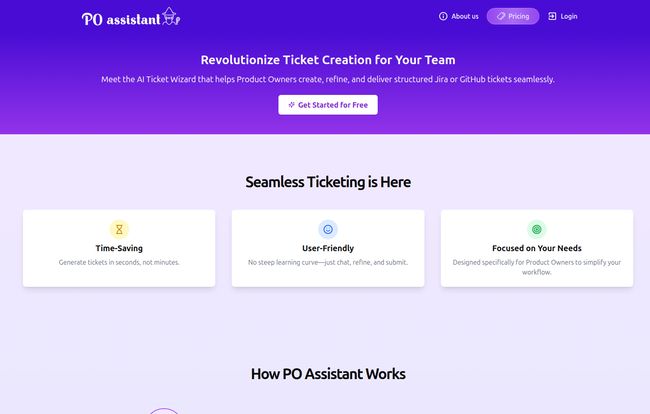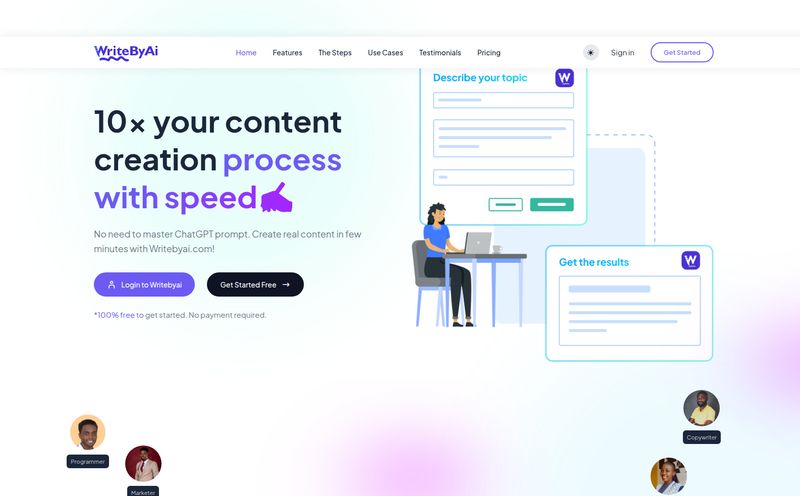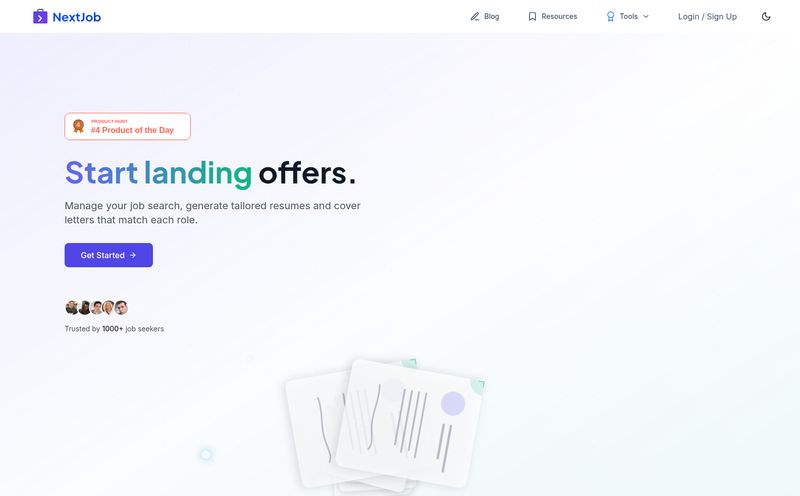If you’re a Product Owner, a good chunk of your week is spent doing something that feels… well, a bit like digital plumbing. I’m talking about writing tickets. User stories, bug reports, tech debt reminders, feature requests that are more of a vague feeling than a concrete plan. It’s the endless, soul-crushing grind of translating brilliant, chaotic ideas into the rigid, structured format of a Jira or GitHub ticket.
I’ve been in this game for a while, and I’ve seen it all. The sprint planning meetings that drag on for hours because the tickets are unclear. The passive-aggressive comments from developers asking for “more detail.” The sheer, mind-numbing volume of it all. It's a necessary evil, the connective tissue of any dev team, but man, does it get old.
So when I see a new tool pop up that claims to be an “AI-powered tool for seamless Jira ticket creation,” my inner skeptic and my exhausted inner PO both sit up and pay attention. The tool is called PO Assistant, and I had to see if it was just another shiny object or a genuinely useful sidekick.
First Off, What Exactly is PO Assistant?
Think of it as a specialized translator. It’s not trying to be the next ChatGPT that can write you a sonnet and a business plan. Instead, it’s laser-focused on one thing: taking your messy, unstructured thoughts, your screenshots, your brain-dumps, and turning them into perfectly formatted tickets. It’s designed specifically for Product Owners (hence the name, I guess), which is a nice change from the generic AI tools that don’t really get our world.
It’s built around an “AI Ticket Wizard,” which is a fancy way of saying you chat with it. You describe the feature or bug, it asks clarifying questions, and then it spits out a structured ticket. Simple as that. Or so they claim.
The Real Pain of the Ticket-Writing Hamster Wheel
Before I get into the nitty-gritty of the tool, let’s just sit with the problem for a moment. A poorly written ticket isn't just an annoyance; it’s a productivity killer. It creates a domino effect of wasted time. The developer has to stop, ask for clarification, you have to stop what you're doing to answer, and suddenly a 2-hour task has eaten up half a day for two people.

Visit PO Assistant
I once wrote a ticket for a simple button change that resulted in the entire user authentication system getting refactored. Why? Because my description was ambiguous. My bad, sure, but it’s a mistake born from fatigue and having 50 other tickets to write that day. We need a buffer. A sanity check. A little helper that doesn’t get tired. That’s the promise here.
So, How Does This AI Wizardry Actually Work?
The process they lay out is refreshingly simple, and in my testing, it holds up. It’s basically a three-step dance:
- Chat with the Ticket Wizard: You open the tool and just start typing or talking. Something like, “Hey, the login button on the checkout page is misaligned on mobile. It looks fine on desktop but on an iPhone 14 it’s pushed too far to the left.” You just dump your thoughts into it.
- Review and Refine: The AI takes your stream of consciousness and turns it into a structured ticket. It will likely generate a clear title, a user story format (“As a user, I want to see the login button correctly aligned so that I can easily complete my purchase”), and acceptance criteria. This is your chance to edit and make sure it captured the essence of the problem.
- Submit to Jira or GitHub: This is the magic part. With one click, it sends the ticket directly to your project backlog. No more copying, pasting, and reformatting between windows. That alone is a pretty big deal.
The Standout Features I Actually Cared About
Any new SaaS tool can look good on the surface. But what about the features that actually make a difference in your day-to-day? Here’s my take.
The Direct Jira & GitHub Integration
I can't stress this enough. This is the feature that separates PO Assistant from just using a generic AI in another browser tab. The friction of context-switching is a real productivity drain. The ability to create, refine, and push a ticket into your actual workflow without leaving the tool is the main selling point. It’s smooth, it works, and it saves clicks. And clicks, over the course of a year, turn into hours.
Image Analysis is a Legitimate Game-Changer
We’ve all been there. Trying to describe a visual bug with only words is like trying to explain a sunset to someone who’s never seen one. It’s frustrating and often ineffective. With PO Assistant, you can just upload a screenshot of the wonky UI element, and the AI will analyze it to understand the context. This is brilliant. It bridges the gap between seeing a problem and describing it, leading to much clearer bug reports and less back-and-forth with the dev team.
Customizable Templates for the Control Freaks (Like Me)
Okay, this one’s a premium feature, but it’s a necessary one. Every team has its own little quirks and preferred ticket formats. Some want Gherkin-style syntax, others need specific fields for epic links or story points. The default templates are good, but the ability to create your own means the tool can adapt to your team's workflow, not the other way around. This is crucial for adoption.
Let's Talk Money: The Pricing Breakdown
So, what's this convenience going to cost you? The pricing structure is pretty straightforward, which I appreciate. No confusing credit systems or enterprise-only secrets.
| Plan | Cost | Key Features & Limitations |
|---|---|---|
| Free Plan | $0 / month | Good for a test drive. You get 5 prompts and 1 image upload per day. Uses default templates only. |
| Premium (Monthly) | $19.99 / month | Unlimited ticket generation, unlimited uploads, fully customizable templates, and early access to new stuff. |
| Premium (Annually) | $159.99 / year | Same as monthly premium, but works out to about $13.33 a month. The better deal if you're sold on it. |
My take? The free plan is a demo. A good one, but you'll hit the limits fast if you're a full-time PO. Is the premium plan worth twenty bucks a month? If you're writing more than 10-15 tickets a week, I'd say absolutely. Calculate your hourly rate. If this tool saves you even one or two hours a month, it has paid for itself. It’s a small price for a whole lot less administrative headache.
The Good, The Bad, and The Nitty-Gritty
No tool is perfect. PO Assistant is incredibly promising, but let's keep it real. The biggest strength is its focus. It saves a ton of time on the repetitive, mundane task of ticket creation, and the user interface is clean and requires basically zero training. The image analysis and direct integration are, frankly, killer features.
On the flip side, the limitations of the free plan are pretty tight. It's a solid taster, but you'll hit the paywal pretty quicky if you're a heavy user. And of course, the most powerful feature for team-wide adoption—the custom templates—is locked behind that paywall. That’s not a surprise, it’s just business, but it's something to be aware of.
So, Who is This Tool Actually For?
This is a tool for the overloaded Product Owner, Project Manager, or even a Scrum Master who gets saddled with backlog grooming. If you live in Jira or GitHub all day and you feel like you're losing the war against your own backlog, this is for you.
Who isn't it for? Maybe a small team or a solo dev who only creates a handful of tickets a week. The manual effort is probably low enough that the subscription fee doesn't make sense. But for any PO in a reasonably-paced agile environment, this feels less like a luxury and more like a necessity.
Frequently Asked Questions
Is PO Assistant just another front-end for ChatGPT?
I don't think so. While it uses powerful AI, its specialization is its strength. The focused workflow, direct integrations with Jira/GitHub, and features like image analysis are specifically designed for the product development lifecycle, which you don't get from a general-purpose chatbot.
Can I use PO Assistant with other project management tools?
As of now, it seems to be focused exclusively on Jira and GitHub. This is probably a good thing, as it allows them to make those integrations really solid. Maybe they'll add others like Asana or Trello in the future, but for now, you need to be in the Atlassian or GitHub ecosystem.
Is the image analysis feature secure?
This is a great question for any cloud tool. You should always review the platform's Privacy Policy and Terms of Service. Generally, reputable SaaS companies take data security seriously, but if your screenshots contain sensitive customer data, it's always wise to exercise caution and double-check their policies.
How much time can I realistically save with this?
It's subjective, but I'd say it could easily cut the time you spend writing tickets by 50-75%. Think about all the time spent structuring, formatting, and refining your language. The AI does that heavy lifting, leaving you to do a quick review. For a busy PO, that could easily be a few hours back every single week.
What happens if I cancel my premium plan?
Typically with this kind of subscription model, your account would revert to the Free Plan at the end of your billing cycle. You'd lose access to unlimited generation, custom templates, and your upload/prompt counts would be reset to the daily free limits.
My Final Verdict on PO Assistant
Look, no AI is going to replace the critical thinking, user empathy, and strategic vision of a great Product Owner. That’s not what this is about. This is about automation. It’s about offloading the most tedious part of your job so you have more brainpower left for the parts that actually require a human.
PO Assistant is a sharp, well-designed tool that solves a real, nagging problem. It’s not just a cool piece of tech; it’s a genuine productivity booster. It’s the sidekick that preps all your gear so you can focus on the main mission. For me, it’s a definite keeper. It might just be the thing that helps you get out from under that mountain of tickets and back to building amazing products.



